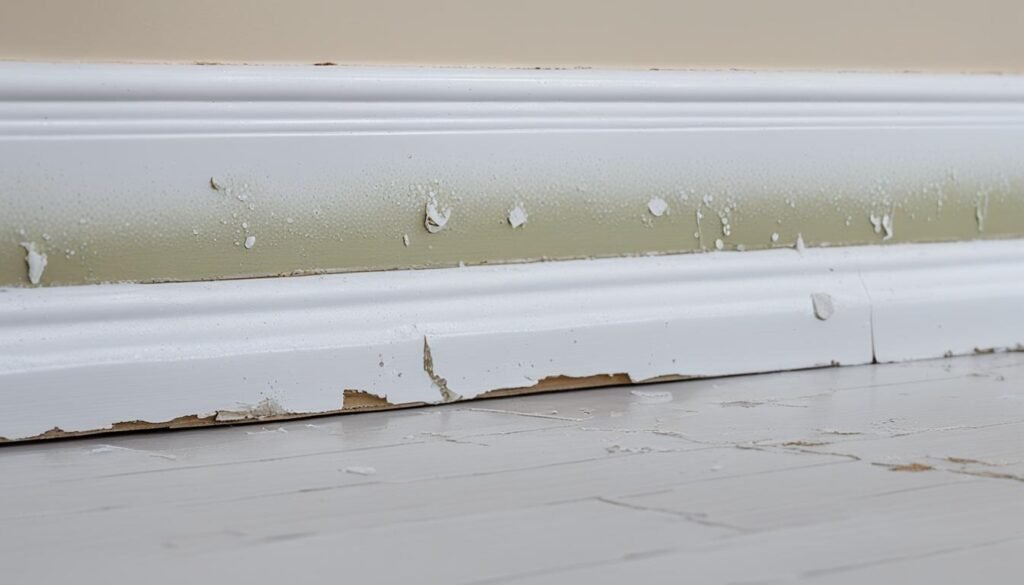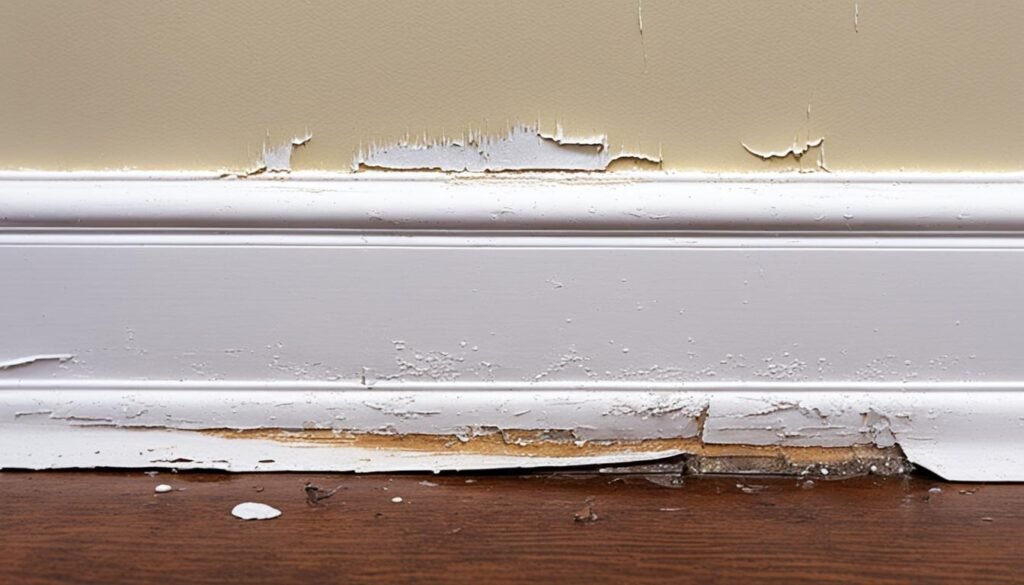Did you know water damage can lead to up to 40% of homeowner insurance claims in the U.S.? It often hits your home’s baseboards hard. Water can make them warp, swell, or even rot. But, you can fix this with the right steps and some knowledge.
Key Takeaways
- Water damage can cause baseboards to warp, swell, or rot, creating an unsightly and potentially hazardous situation.
- With the right approach and a bit of know-how, you can restore your water-damaged baseboards to their former glory.
- This step-by-step guide will provide you with practical tips on how to fix your lightly water-damaged baseboards.
- Properly identifying and assessing the extent of the water damage is crucial for a successful repair.
- Addressing the root cause of the water damage is essential to prevent future issues.
This guide will walk you through fixing your water-damaged baseboards step by step. We’ll cover identifying damage and the repair process. By the end, your baseboards will look as good as new. Let’s get started and fix those water-damaged baseboards!
Identifying and Assessing Water Damage on Baseboards
Start by looking closely at the baseboards for signs of water damage. Check for warping, swelling, discoloration, or softness. These signs often show where water has gotten in.
Press gently on the baseboards to see if they feel spongy or soft. This can mean water has soaked into the surface. Knowing how bad the damage is will help you decide if you can fix the baseboards or if they need to be replaced.
Signs of Water Damage
- Moisture stains on baseboards
- Mold growth on baseboards
- Warping and peeling paint on baseboards
- Dripping sounds behind baseboards
Causes of Water Damage on Baseboards
Water damage can come from many sources, like hidden leaks, clogged gutters, severe weather, malfunctioning appliances, and HVAC issues. A small leak can quickly become a big problem, affecting your drywall, floors, and more. It’s important to find and fix the cause to stop more damage.
“A tiny hidden leak can turn into a massive problem for your drywall, floors, and other parts of your home.”
By checking your baseboards and knowing what causes water damage, you can protect your home. This helps prevent further damage.
How to Repair Water Damaged Baseboards
If your home has experienced water damage, fixing the baseboards is key to getting things back to normal. This guide will show you how to repair water damaged baseboards. It covers removing and replacing the damaged boards, drying the area, and fixing minor issues.
To start, remove the damaged baseboards. Use a utility knife to score the top edge, breaking the paint seal. Then, gently pry the baseboard away from the wall. This lets you see how bad the damage is and what to do next.
After taking out the damaged baseboards, make sure the area is dry. Use fans, dehumidifiers, or other drying tools to get it completely dry. This step is crucial to avoid more damage and mold.
If the damage is minor, you might be able to fix the baseboards you already have. Sand the damaged spots, then fill in any cracks with wood filler. After the filler dries, sand again and paint over the repair to match the rest of the baseboard.
For serious water damage, you’ll need to replace the baseboards completely. Measure, cut, and install new baseboards with wood adhesive and nails. Don’t forget to seal any gaps with caulk to keep water out.
By using these steps to repair water damaged baseboards, you can make your home look great again. You’ll protect against more damage and ensure your walls and floors work well together.

Fixing water damage on your baseboards quickly is important to avoid bigger, more expensive repairs later. Take your time to remove and replace water damaged baseboards right. Your home will soon be in top shape.
Conclusion
Fixing water-damaged baseboards might seem hard, but this guide makes it easier. Start by checking the damage, then carefully remove the damaged boards. Make sure the area is dry before you begin repairs or replace the boards. Finally, finish them off with a professional touch.
Fixing or replacing water-damaged baseboards does more than just improve your home’s look. It also stops problems like mold or structural damage. With your baseboards fixed, your home will look great again!
It’s crucial to fix water-damaged baseboards right away. If you don’t, you might face bigger and more expensive repairs later. By fixing the damage now, you can stop future problems and keep your home safe and sound.


